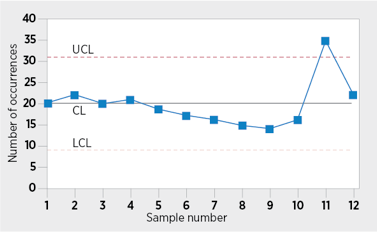What Tool Can You Use to Determine Whether a Process Is in Control or Out of Control?
Control Chart
Quality Glossary Definition: Control chart
Also called: Shewhart chart, statistical process control chart
The command chart is a graph used to study how a procedure changes over time. Data are plotted in time society. A control chart always has a central line for the boilerplate, an upper line for the upper control limit, and a lower line for the lower control limit. These lines are determined from historical data. By comparing current data to these lines, you can describe conclusions about whether the process variation is consistent (in control) or is unpredictable (out of control, afflicted by special causes of variation). This versatile data collection and analysis tool can be used by a variety of industries and is considered i of the seven basic quality tools.
Command charts for variable data are used in pairs. The peak nautical chart monitors the boilerplate, or the centering of the distribution of data from the process. The bottom chart monitors the range, or the width of the distribution. If your information were shots in target practise, the average is where the shots are clustering, and the range is how tightly they are amassed. Command charts for attribute data are used singly.
- When to apply a control nautical chart
- Basic process
- Create a command chart
- Control chart resources

Control Chart Case
When to Use a Control Chart
- When controlling ongoing processes past finding and correcting problems every bit they occur
- When predicting the expected range of outcomes from a procedure
- When determining whether a procedure is stable (in statistical control)
- When analyzing patterns of process variation from special causes (non-routine events) or mutual causes (built into the procedure)
- When determining whether your quality comeback project should aim to prevent specific issues or to brand central changes to the procedure
Basic Procedure
- Cull the appropriate command chart for your data.
- Determine the advisable time period for collecting and plotting data.
- Collect information, construct your chart and clarify the information.
- Look for "out-of-control signals" on the command nautical chart. When one is identified, mark it on the chart and investigate the crusade. Document how yous investigated, what you learned, the cause and how information technology was corrected.
Out-of-control signals
- A unmarried indicate exterior the control limits. In Figure 1, point 16 is above the UCL (upper control limit).
- Two out of three successive points are on the same side of the centerline and farther than ii σ from it. In Figure 1, indicate 4 sends that bespeak.
- Four out of v successive points are on the same side of the centerline and farther than i σ from it. In Figure ane, point 11 sends that signal.
- A run of eight in a row are on the aforementioned side of the centerline. Or 10 out of 11, 12 out of 14, or 16 out of 20. In Figure one, point 21 is eighth in a row to a higher place the centerline.
- Obvious consistent or persistent patterns that advise something unusual nigh your data and your process.

Figure one Control Chart: Out-of-Command Signals
- Continue to plot data as they are generated. Equally each new data point is plotted, cheque for new out-of-control signals.
- When yous beginning a new control chart, the process may be out of control. If and then, the command limits calculated from the outset 20 points are provisional limits. When you have at least 20 sequential points from a period when the procedure is operating in control, recalculate control limits.
Create a control chart
See a sample control chart and create your own with the control chart template (Excel).
Control Chart Resource
You can besides search articles, case studies, and publications for control chart resources.
Books
The Quality Toolbox
Innovative Control Charting
Improving Healthcare With Control Charts
Case Studies
Using Control Charts In A Healthcare Setting (PDF) This education case study features characters, hospitals, and healthcare data that are all fictional. Upon use of the example report in classrooms or organizations, readers should be able to create a control chart and translate its results, and identify situations that would be appropriate for command chart analysis.
Quality Quandaries: Interpretation Of Signals From Runs Rules In Shewhart Control Charts (Quality Technology) The example of Douwe Egberts, a Dutch tea and coffee manufacturer/benefactor, demonstrates how run rules and a Shewhart control chart tin exist used equally an effective statistical process control tool.
Articles
Spatial Command Charts For The Mean (Journal of Quality Engineering science) The properties of this control chart for the means of a spatial procedure are explored with faux information and the method is illustrated with an example using ultrasonic technology to obtain nondestructive measurements of canteen thickness.
A Robust Standard Deviation Control Chart (Technometrics) Nigh robust estimators in the literature are robust against either lengthened disturbances or localized disturbances but non both. The authors advise an intuitive algorithm that is robust against both types of disturbance and has amend overall performance than existing estimators.
Videos
Command Nautical chart
Excerpted from The Quality Toolbox , ASQ Quality Press.
tomlinwhernswille89.blogspot.com
Source: https://asq.org/quality-resources/control-chart
0 Response to "What Tool Can You Use to Determine Whether a Process Is in Control or Out of Control?"
Enregistrer un commentaire